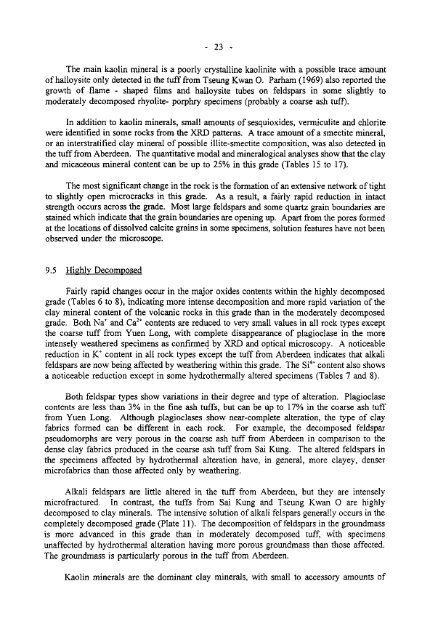mineralogical and fabric characterization and classification of ...
mineralogical and fabric characterization and classification of ...
mineralogical and fabric characterization and classification of ...
You also want an ePaper? Increase the reach of your titles
YUMPU automatically turns print PDFs into web optimized ePapers that Google loves.
- 23 -The main kaolin mineral is a poorly crystalline kaolinite with a possible trace amount<strong>of</strong> halloysite only detected in the tuff from Tseung Kwan O. Parham (1969) also reported thegrowth <strong>of</strong> flame - shaped films <strong>and</strong> halloysite tubes on feldspars in some slightly tomoderately decomposed rhyolite- porphry specimens (probably a coarse ash tuff).In addition to kaolin minerals, small amounts <strong>of</strong> sesquioxides, vermiculite <strong>and</strong> chloritewere identified in some rocks from the XRD patterns. A trace amount <strong>of</strong> a smectite mineral,or an interstratified clay mineral <strong>of</strong> possible illite-smectite composition, was also detected inthe tuff from Aberdeen. The quantitative modal <strong>and</strong> <strong>mineralogical</strong> analyses show that the clay<strong>and</strong> micaceous mineral content can be up to 25% in this grade (Tables 15 to 17).The most significant change in the rock is the formation <strong>of</strong> an extensive network <strong>of</strong> tightto slightly open microcracks in this grade. As a result, a fairly rapid reduction in intactstrength occurs across the grade. Most large feldspars <strong>and</strong> some quartz grain boundaries arestained which indicate that the grain boundaries are opening up. Apart from the pores formedat the locations <strong>of</strong> dissolved calcite grains in some specimens, solution features have not beenobserved under the microscope.9.5 Highly DecomposedFairly rapid changes occur in the major oxides contents within the highly decomposedgrade (Tables 6 to 8), indicating more intense decomposition <strong>and</strong> more rapid variation <strong>of</strong> theclay mineral content <strong>of</strong> the volcanic rocks in this grade than in the moderately decomposedgrade. Both Na + <strong>and</strong> Ca 2+ contents are reduced to very small values in all rock types exceptthe coarse tuff from Yuen Long, with complete disappearance <strong>of</strong> plagioclase in the moreintensely weathered specimens as confirmed by XRD <strong>and</strong> optical microscopy. A noticeablereduction in K + content in all rock types except the tuff from Aberdeen indicates that alkalifeldspars are now being affected by weathering within this grade. The Si 4+ content also showsa noticeable reduction except in some hydrothermally altered specimens (Tables 7 <strong>and</strong> 8).Both feldspar types show variations in their degree <strong>and</strong> type <strong>of</strong> alteration. Plagioclasecontents are less than 3% in the fine ash tuffs, but can be up to 17% in the coarse ash tufffrom Yuen Long. Although plagioclases show near-complete alteration, the type <strong>of</strong> clay<strong>fabric</strong>s formed can be different in each rock. For example, the decomposed feldsparpseudomorphs are very porous in the coarse ash tuff from Aberdeen in comparison to thedense clay <strong>fabric</strong>s produced in the coarse ash tuff from Sai Kung. The altered feldspars inthe specimens affected by hydrothermal alteration have, in general, more clayey, densermicro <strong>fabric</strong>s than those affected only by weathering.Alkali feldspars are little altered in the tuff from Aberdeen, but they are intenselymicr<strong>of</strong>ractured. In contrast, the tuffs from Sai Kung <strong>and</strong> Tseung Kwan 0 are highlydecomposed to clay minerals. The intensive solution <strong>of</strong> alkali felspars generally occurs in thecompletely decomposed grade (Plate 11). The decomposition <strong>of</strong> feldspars in the groundmassis more advanced in this grade than in moderately decomposed tuff, with specimensunaffected by hydrothermal alteration having more porous groundmass than those affected.The groundmass is particularly porous in the tuff from Aberdeen.Kaolin minerals are the dominant clay minerals, with small to accessory amounts <strong>of</strong>
















